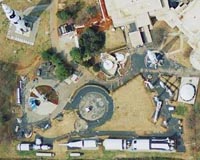 |
Effelsberg, Germany (SPX) Dec 22, 2009 Scientists at the Max Planck Institut for Radio Astronomy have made the first LOFAR "all-sky" images in the 110 to 190 MHz range using LOFAR high-band antennas at the LOFAR station in Effelsberg, Germany. These images are the first high-band, all-sky images made from any complete LOFAR station, and mark a significant milestone in the development of the LOFAR project. The two bright (yellow) spots are Cygnus A, a giant radio galaxy powered by a supermassive black hole near, the center of the image, and Cassiopeia A, a bright radio source created by a supernova explosion about 300 years ago, at the upper-left in the image. The plane of our Milky Way galaxy can also be seen passing by both Cassiopeia A and Cygnus A, and extending down to the bottom of the image. The North Polar Spur, a large cloud of radio emission within our own galaxy, can also be seen extending from the direction of the Galactic center in the South, toward the western horizon in this image. "We made this image with a single 60 second "exposure" at 120 MHz using our high-band LOFAR field in Effelsberg", says James Anderson, project manager of the Effelsberg LOFAR station. "The ability to make all-sky images in just seconds is a tremendous advancement compared to existing radio telescopes which often require weeks or months to scan the entire sky." This opens up exciting possibilities to detect and study rapid transient phenomena in the universe. LOFAR, the LOw Frequency ARray, is an advanced new radio telescope being built in many countries across Europe. Operating at relatively low radio frequencies from 10 to 240 MHz, LOFAR has essentially no moving parts to track objects in the sky --- instead digital electronics are used to combine signals from many small antennas to electronically steer observations on the sky. In certain electronic modes, the signals from all of the individual antennas can be combined to make images of the entire radio sky visible above the horizon. LOFAR uses two different antenna designs, to observe in two different radio bands, the so-called low-band from 10 to 80 MHz, and the high-band from 110 to 240 MHz. All-sky images using the low-band antennas at Effelsberg were made in 2007. Following the observation for the first high-band, all-sky image, scientists at MPIfR made a series of all-sky images covering a wide frequency range using both the low-band and high-band antennas at Effelsberg. Scientists at MPIfR and other institutions around Europe will use measurements such as these to study the large-sky structure of the interstellar matter of our Milky Way galaxy. The low frequencies observed by LOFAR are ideal for studying the low energy cosmic ray electrons in the Milky Way, which trace out magnetic field structures through synchrotron emission. Other large-scale features such as supernova remnants, star-formation regions, and even some other nearby galaxies will need similar measurements from individual LOFAR telescopes to provide accurate information on the large-scale emission in these objects. "We plan to search for radio transients using the all-sky imaging capabilities of the LOFAR telescopes", says Michael Kramer, director at the Max Planck Institute for Radio Astronomy (MPIfR) in Bonn. "The detection of rapidly variable sources using LOFAR could lead to exciting discoveries of new types of astronomical objects, similar to the discoveries of pulsars and gamma-ray bursts in the past decades." "The low-frequency sky is now truly open in Effelsberg and we have the capability at the observatory to observe in a wide frequency range from 10 MHz to 100 GHz", says Anton Zensus, also director at MPIfR. "Thus we can cover four orders of magnitude in the electromagnetic spectrum." Share This Article With Planet Earth
Related Links Max Planck Institut for Radio Astronomy The latest information about the Commercial Satellite Industry
 AFSPC Reaches Out To Space Camp Youth
AFSPC Reaches Out To Space Camp YouthPeterson AFB CO (SPX) Nov 04, 2009 Could a U.S. Space and Rocket Center, Space Camp grad be the next U.S Air Force F-16 Pilot or GPS System operator? The Air Force only hopes so. The U.S. Space and Rocket Center is located in Huntsville, Alabama. "Space Camp" is what the center is commonly known as and provides residental and day camp educational programs for children in various age groups and adults. Space Camp is a series ... read more |
|
| The content herein, unless otherwise known to be public domain, are Copyright 1995-2009 - SpaceDaily. AFP and UPI Wire Stories are copyright Agence France-Presse and United Press International. ESA Portal Reports are copyright European Space Agency. All NASA sourced material is public domain. Additional copyrights may apply in whole or part to other bona fide parties. Advertising does not imply endorsement,agreement or approval of any opinions, statements or information provided by SpaceDaily on any Web page published or hosted by SpaceDaily. Privacy Statement |